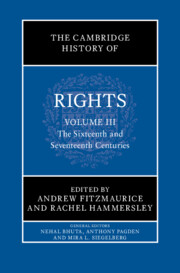Refine listing
Actions for selected content:
1299955 results in Books
Part IV - Modern Causal Inference
-
- Book:
- Advances in Economics and Econometrics
- Published online:
- 11 November 2025
- Print publication:
- 31 January 2026, pp 193-194
-
- Chapter
- Export citation
1 - Corporations and Fascism in ‘New’ India
-
-
- Book:
- The Politics of Corporations in ‘New’ India
- Published online:
- 15 December 2025
- Print publication:
- 31 January 2026, pp 1-41
-
- Chapter
- Export citation
Copyright page
-
- Book:
- Sarah Wambaugh and the Plebiscite
- Published online:
- 23 December 2025
- Print publication:
- 31 January 2026, pp vi-vi
-
- Chapter
- Export citation
Index
-
- Book:
- Advances in Economics and Econometrics
- Published online:
- 11 November 2025
- Print publication:
- 31 January 2026, pp 333-340
-
- Chapter
- Export citation
Acknowledgements
-
- Book:
- Chance
- Published online:
- 26 December 2025
- Print publication:
- 31 January 2026, pp xix-xx
-
- Chapter
- Export citation
1 - Introduction
-
- Book:
- Conversations on Rational Choice
- Print publication:
- 31 January 2026, pp 1-7
-
- Chapter
- Export citation
Index
-
- Book:
- Advances in Economics and Econometrics
- Published online:
- 28 November 2025
- Print publication:
- 31 January 2026, pp 441-459
-
- Chapter
- Export citation
1 - Techno-missionaries
- from Part I - Growth
-
- Book:
- Charity After Empire
- Published online:
- 18 December 2025
- Print publication:
- 31 January 2026, pp 29-60
-
- Chapter
- Export citation

The Cambridge History of Rights
- Coming soon
-
- Expected online publication date:
- January 2026
- Print publication:
- 29 January 2026
-
- Book
- Export citation
8 - One-Dimensional Mania: Unmasking the Nexus of Brahmanical Hindutva, Corporate Dispossession, and State Violence in India
-
-
- Book:
- The Politics of Corporations in ‘New’ India
- Published online:
- 15 December 2025
- Print publication:
- 31 January 2026, pp 181-215
-
- Chapter
- Export citation
Contents
-
- Book:
- Conversations on Rational Choice
- Print publication:
- 31 January 2026, pp v-vi
-
- Chapter
- Export citation
Conclusion
-
- Book:
- Sarah Wambaugh and the Plebiscite
- Published online:
- 23 December 2025
- Print publication:
- 31 January 2026, pp 273-276
-
- Chapter
- Export citation
Chance, A Tale in Two Parts
-
- Book:
- Chance
- Published online:
- 26 December 2025
- Print publication:
- 31 January 2026, pp 1-4
-
- Chapter
- Export citation
Dedication
-
- Book:
- The Technosystem of Free Speech
- Print publication:
- 31 January 2026, pp ix-x
-
- Chapter
- Export citation
About the Contributors
-
- Book:
- The Politics of Corporations in ‘New’ India
- Published online:
- 15 December 2025
- Print publication:
- 31 January 2026, pp 340-344
-
- Chapter
- Export citation
7 - Postwar Reconstruction, 1941–1942
-
- Book:
- James Meade
- Print publication:
- 31 January 2026, pp 194-236
-
- Chapter
- Export citation
Part I - Contests and Contracts
-
- Book:
- Advances in Economics and Econometrics
- Published online:
- 28 November 2025
- Print publication:
- 31 January 2026, pp 1-2
-
- Chapter
- Export citation
Abbreviations and Note on Editions
-
- Book:
- Chance
- Published online:
- 26 December 2025
- Print publication:
- 31 January 2026, pp xxvii-xxviii
-
- Chapter
- Export citation
Part II - Delivery
-
- Book:
- Charity After Empire
- Published online:
- 18 December 2025
- Print publication:
- 31 January 2026, pp 137-252
-
- Chapter
- Export citation
Acknowledgments
-
- Book:
- The Indian Ocean and the Historical Imagination in Afro-Asian Fiction
- Published online:
- 19 December 2025
- Print publication:
- 31 January 2026, pp x-xiv
-
- Chapter
- Export citation
